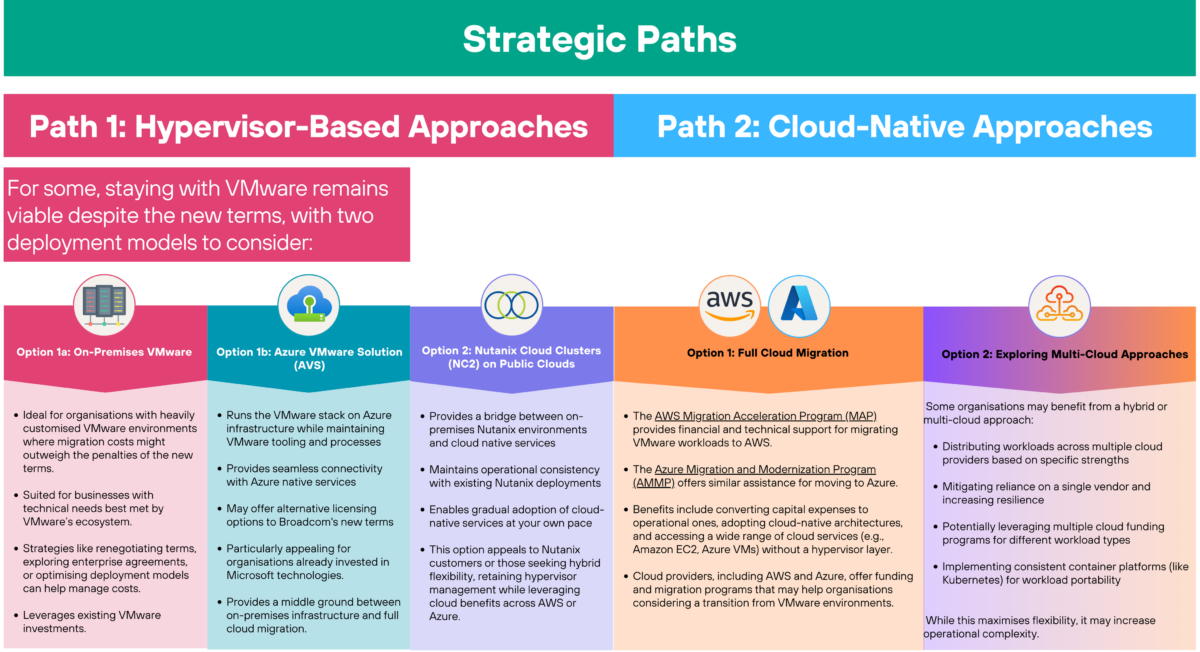Navigating VMware’s New Licensing Changes: Strategic Considerations for Enterprise IT

Aashish Jolly
Principal Solutions Architect, Versent

Aashish Jolly
Principal Solutions Architect, Versent
Understanding the Changing Landscape
Enterprise IT leaders are evaluating VMware’s updated licensing terms, which, according to reports from CRN and The Register, include a significant increase in the minimum license requirements from 16 to 72 cores per CPU and a 20% late renewal penalty starting April 10, 2025. These changes may prompt some organisations to reassess their virtualisation strategies. Meanwhile, cloud providers like AWS and Azure offer programs and incentives that present compelling alternatives for organisations exploring cloud-based infrastructure options.
As IT leaders navigate these developments, understanding the implications of VMware’s policy shifts and evaluating available paths forward is critical. This article provides a balanced perspective to support informed decision-making tailored to your organisation’s unique needs.
The Evolving VMware Landscape
VMware’s licensing updates—including the reported shift to a 72-core minimum and the 20% late renewal penalty—reflect industry trends and the company’s strategic direction following its acquisition by Broadcom. While potentially aimed at enhancing licensing predictability, these changes could have significant cost implications for organisations, particularly those with smaller workloads or delayed renewal cycles. For enterprises deeply invested in VMware, this moment offers a chance to reassess the Total Cost of Ownership (TCO) and evaluate whether sticking with VMware aligns with long-term business and digital transformation goals.
Although VMware has not officially confirmed these changes as of April 2, 2025, the consistency of reports from trusted sources like CRN and The Register suggests a notable shift is on the horizon. Organisations nearing renewal deadlines may benefit from early evaluations to align technical and financial strategies.
Evaluating Your Options
With these licensing changes in play, organisations can choose between two primary strategic paths, each with distinct sub-options.
Each path offers unique advantages, and the best choice depends on your organisation’s priorities, workload characteristics, and strategic objectives.

Strategic Considerations for Decision-Making
Regardless of which direction you choose, several key factors should inform your decision:
Total Cost of Ownership Analysis
Look beyond initial licensing costs to include:
- Hardware refresh cycles and maintenance
- Administrative overhead for each option
- Training and skill development requirements
- Long-term cost projections across multiple scenarios
A thorough analysis can help organisations determine the most cost-effective solution based on workload characteristics and business requirements.
Migration Complexity Assessment
Before making any changes, evaluate:
- Application dependencies and compatibility requirements
- Data transfer considerations and potential challenges
- Business continuity requirements during transitions
- Available internal resources versus partner support needs
Organisations with complex, highly integrated environments face different challenges than those with more standardised workloads.
Strategic Alignment
Consider how each option aligns with broader IT strategies:
- Digital transformation initiatives that might benefit from cloud-native capabilities
- Organisational priorities regarding vendor diversification
- Future scalability and flexibility requirements
- Regulatory compliance and data sovereignty considerations
The ideal solution should support both immediate needs and long-term strategic goals.
Creating Your Action Plan
If you’re concerned about VMware’s policy changes, consider this methodical approach:
- Inventory Workloads: Categorise based on migration complexity, business criticality, and cloud-readiness
- Explore funding programs: Assess AWS MAP and Azure AMMP, to understand potential financial support
- Analyse Scenarios: Compare hypervisor-based and cloud-native approaches
- Create a phased migration strategy that prioritises workloads based on renewal timelines and migration complexity
- Assess organisational readiness: Evaluate skills, governance, and operational models for each approach
The best approach for each organisation will depend on its circumstances, including VMware investments, available resources, and strategic goals.
Making Informed Decisions
VMware’s updated licensing terms introduce changes that organisations may want to carefully evaluate in the context of their long-term IT strategy. Whether you choose a hypervisor-based approach (continuing with VMware, adopting Nutanix NC2, or migrating to AVS) or pursue a cloud-native strategy (with AWS, Azure, or multi-cloud), the key is making your decision based on comprehensive analysis rather than reactive responses.
For organisations considering cloud migration, both AWS MAP and Azure AMMP provide a timely opportunity to reduce transition costs. However, any migration decision should be driven primarily by long-term strategic fit rather than short-term incentives.
As technology leaders navigate these changes, remember that infrastructure decisions should ultimately support business outcomes. The right approach will balance technical considerations with financial implications and organisational readiness, ensuring your infrastructure strategy supports rather than constrains your business objectives.
Engaging with Versent’s Cloud specialists can provide tailored insights, whether you seek guidance on migration options or a detailed infrastructure assessment.
contact us today: cto-services@versent.com.au